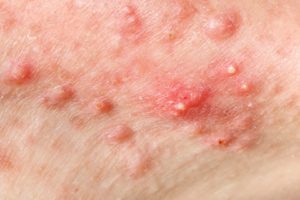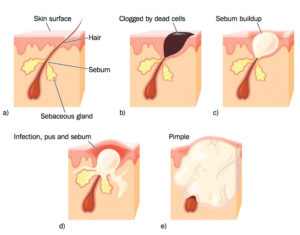 Acne not only affects teenagers but many adults as well. It is the most common skin condition in the United States. Finding accurate information on the causes and treatments of acne can be difficult. At Advanced Dermatology, we have been able to help many people affected with acne by customizing a regimen that works for them. Not only can we treat your existing acne, but also help prevent future breakouts.
Acne not only affects teenagers but many adults as well. It is the most common skin condition in the United States. Finding accurate information on the causes and treatments of acne can be difficult. At Advanced Dermatology, we have been able to help many people affected with acne by customizing a regimen that works for them. Not only can we treat your existing acne, but also help prevent future breakouts.
Types of acne:
- Cystic
- Inflammatory
- Comedonal
There are many effective treatments for acne. It is important to treat acne. Without treatment, acne can cause permanent scarring and dark spots on the skin. Not only can treating acne boost a person’s self-esteem, it can lower the risk of leaving permanent scars.
 Approximately 50 million Americans are affected by acne. Acne can occur at any age from newborn babies through late adulthood. When the body makes a lot of sebum (oil), our dead skin cells stick together inside of our pores rather than rising to the surface to be shed; resulting in acne. There are several factors that cause this.
Approximately 50 million Americans are affected by acne. Acne can occur at any age from newborn babies through late adulthood. When the body makes a lot of sebum (oil), our dead skin cells stick together inside of our pores rather than rising to the surface to be shed; resulting in acne. There are several factors that cause this.
- Bacteria
Bacteria that lives on our skin can also get inside a clogged pore. This is a perfect sticky environment for the bacteria to grow. The excess bacteria causes the pore to become red and swollen and can result in a cyst or nodule. - Diet
Diets high in carbohydrates, sugar and dairy result in raised insulin levels. This contributes to a higher production of sebum (oil). Sebum makes our cells sticky, resulting in clogged pores. - Hormonal influences
Sebum production can be influenced by hormonal changes that occur during puberty, menstruation and pregnancy. - Abnormal maturation of the skin
There are many effective treatments for acne. The same medication does not work for everyone. Because acne is caused by multiple factors, acne treatment often requires both an oral and a topical medication. With the variety of medications available today, most cases of acne can be controlled.
Some of the most common topical (applied to the skin) treatments are:
- Benzoyl Peroxide
- Topical antibiotics
- Topical retinoids
- Topical Dapsone
Products containing benzoyl peroxide will bleach or stain fabrics so make sure the medication is completely dry before putting on clothing. Also, it is wise to use old towels, wash cloths and pillowcases as they will bleach these fabrics as well.
Oral medications are used to treat acne that is more severe. Some of the common treatments are:
- Antibiotics (reduces inflammation by killing bacteria)
- Spironalactone (blocks male hormone production which decreases oil production)
- Birth Control Pills (can decrease hormone production which decreases oil production)
- Isotretinoin (decreases oil production)
There are other treatments that can be used to treat acne; however, these are not considered standard treatment and are not normally covered by insurance companies. These include:
- Photodynamic therapy (blue light) – This treatment shrinks oil glands; thus, there is a decrease in oil production. You must stay out of the sun for 48 hours following this treatment. You will experience redness for approximately 5 days after the treatment.
- Chemical Peels – Peels come in different strengths and must be applied by a professional. A series of 3-6 peels is optimal for best results.
- Extractions – Large lesions not responding to medication can be extracted to help ease pain and reduce the risk of scarring. Lesions can also be injected with medication (steroids) for quicker clearing.
Treatment of acne isn’t always easy and it can be frustrating waiting on it to clear. Often, acne can get worse before it gets better. It is important for you to be patient and use your medications as prescribed. You should expect about a 50% improvement within 4-6 months of treatment. Once your skin improves, you should not stop your treatment unless instructed by your physician. Continuing treatment will help prevent new breakouts.


